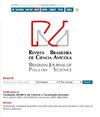传统和有机肉鸡肠致病性(EPEC)和产志贺氧性大肠杆菌(STEC)的检测及耐药性分析
IF 1.1
4区 农林科学
Q3 AGRICULTURE, DAIRY & ANIMAL SCIENCE
引用次数: 0
摘要
本文章由计算机程序翻译,如有差异,请以英文原文为准。
Detection and Antimicrobial Resistance Profile of Enteropathogenic (EPEC) and Shigatoxigenic Escherichia coli (STEC) in Conventional and Organic Broiler Chickens
Enteropatogenic Escherichia coli (EPEC) and shigatoxigenic E. coli (STEC), are generally poultry and poultry product isolate and can cause serious human infections. Many strains may become resistant to various antimicrobials, which can hinder the treatment of bacterial diseases. Organic farming seeks to avoid the selection and frequency of antimicrobial-resistant bacteria. This study aims to verify the resistance of EPEC and STEC from organic and conventional (industrial) broiler isolates to antimicrobials. All isolates were submitted to disk diffusion test with tetracycline, gentamicin, enrofloxacin, ceftriaxone and amoxicillin + clavulanate (TET, GEN, ENO, CTX, AMC) and PCR to detect specific virulence genes for EPEC and STEC. A total of 297 E. coli strains were isolated, 213 from conventional. In organic broiler, 84 strains were isolated. The strains from the conventional broiler isolates were resistant to five antimicrobials tested: TET 48.82% (104/213), ENO 28.17% (60/213), CTX 15.49% (33/213), GEN 14.55% (31/213), and AMC 7.04% (15/213), and 9.86% (21/213) were considered multidrug-resistant. Organic chicken strains were resistant to four of the antimicrobials tested: TET 35.7% (30/84), ENO 9.5% (8/84), CTX 2.4% (2/84), GEN 4.8% (4/84). Of the strains from the organic broiler chicken isolates, only 1.2% (1/84) was considered multidrug-resistant. No EPEC and STEC were found in the organic chicken samples. The multidrug resistance was characterized in 9.52% (2/21) of the EPEC and 4.76% (1/21) of the STEC. The study demonstrated the absence of EPEC and STEC strains in organic broilers and carcasses and a lower frequency of multiresistant strains compared to conventional breeding.
求助全文
通过发布文献求助,成功后即可免费获取论文全文。
去求助
来源期刊

Brazilian Journal of Poultry Science
农林科学-奶制品与动物科学
CiteScore
1.80
自引率
9.10%
发文量
60
审稿时长
>12 weeks
期刊介绍:
A Revista Brasileira de Ciência Avícola surgiu em 1999 a partir da necessidade que a comunidade científica possuía de um periódico para veiculação e publicação de seus trabalhos, com a publicação de três números anuais.
A Revista conta hoje com um corpo editorial altamente qualificado e com artigos científicos desenvolvidos pelos maiores especialistas da área, o que a cada dia atrai mais leitores em busca de inovação e respaldo técnico.
Devido à credibilidade que conquistou pelos esforços de sus autores, relatores e revisores, a Revista ganhou caráter de coleção, sendo consultada como fonte segura de estudo desenvolvidos na Avicultura.
A partir de 2003 – volume 5 -, a Revista passou a chamar-se Brazilian Journal of Poultry Science, e todos os trabalhos passaram a ser publicados em inglês. No mesmo ano subiu para quatro o número de revistas por volume, ampliando-se assim os trabalhos publicados anualmente.
 求助内容:
求助内容: 应助结果提醒方式:
应助结果提醒方式:


